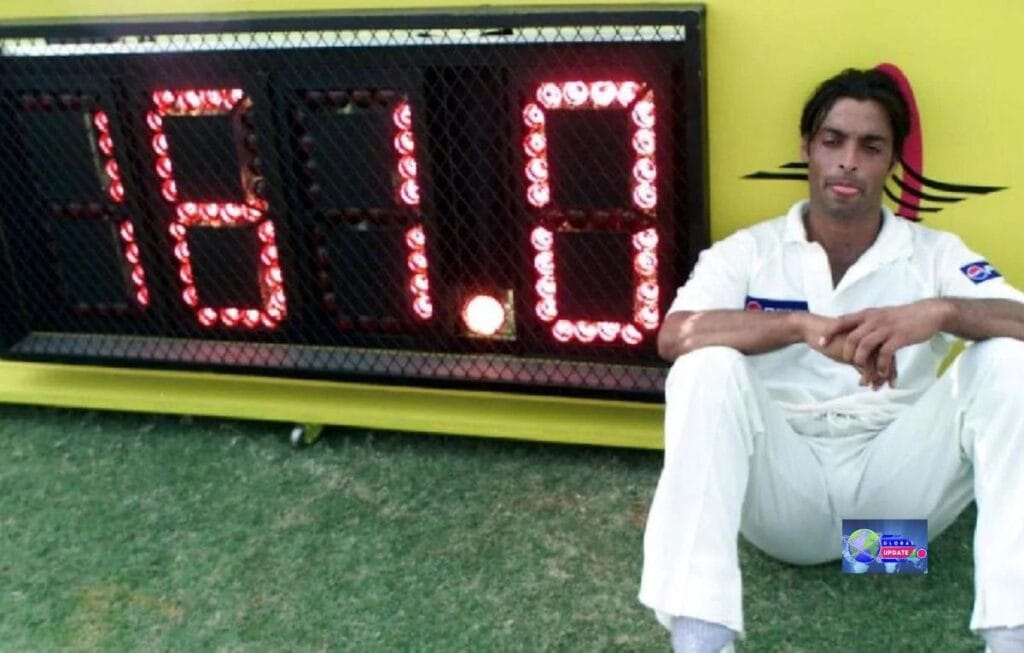Pakistan’s legendary quick bowler Shoaib Akhtar continues to hold the world record for the fastest delivery in One Day International (ODI) cricket, a remarkable feat that has stood unbroken for over two decades.
Known as the “Rawalpindi Express”, Akhtar achieved this milestone during a 2003 Cricket World Cup match against England, where he bowled a thunderous delivery clocked at 161.3 km/h (100.2 mph).
This extraordinary speed officially entered the record books, earning him global recognition as one of the fastest bowlers in cricket history.
Despite modern pace sensations like Mitchell Starc and Lockie Ferguson consistently touching speeds above 155 km/h, none have surpassed Akhtar’s blistering record.
His achievement remains a benchmark of raw pace, strength, and precision—cementing his legacy as one of the most fearsome fast bowlers the game has ever seen.
Record-Holder and Key Figure
Shoaib Akhtar, of Pakistan, holds the officially recognised record for the fastest ball in ODI cricket. He delivered a delivery clock at 161.3 km/h (≈100.2 mph) during a match against England in the 2003 Cricket World Cup.
Details of the Delivery
- During the 2003 World Cup in Cape Town, a game between Pakistan and England set a record for speed of 161.3 km/h.
- On that same over, Akhtar is reported to have bowled multiple deliveries exceeding 150 km/h (for example, speeds like 158.4 and 159.5 km/h) during that match.
- This remarkable feat led to him being popularly nicknamed the “Rawalpindi Express”.
Why This Record Matters
- Breaking the 100 mph (≈160.9 km/h) barrier in cricket is extremely rare; Akhtar remains one of the very few to surpass it in ODIs officially.
- High-velocity bowling changes the dynamics of bat-versus-ball, giving bowlers a significant edge by reducing the reaction time for batters.
- Such speed records become benchmarks for generations of quick bowlers and inspire analysis of factors such as pace, technique, fitness, and equipment.
Recent Controversy & Claims
- A broadcast speed gun showed Mitchell Starc of Australia clocking 176.5 km/h during an ODI against India in October 2025. Many fans speculated that this could have broken Akhtar’s record.
- However, further investigation found that the reading was likely a speed gun error, and the cricketing authorities did not officially ratify the 176.5 km/h as a record. Akhtar’s 161.3 km/h remains the recognised benchmark.
Additional Notable Speeds & Context
- Other bowlers have also been recorded with extremely high speeds in ODIs, such as Shaun Tait of Australia (161.1 km/h) and Brett Lee (also around 161.1 km/h) in their prime.
- The measurement of bowling speed depends on radar/gun equipment, calibration, and location. This official validation indicates that some claims are still unverified or speculative.
Implications for Fast-Bowlers & Cricket
- Akhtar’s record sets a performance target for elite pace bowlers aiming to break the 100 mph barrier in ODIs.
- Modern fitness, biomechanics, pitch conditions, and technology make high-speed bowling more feasible—but sustaining it over a career remains challenging due to injury risk.
- Records like this contribute to cricketing lore and fan interest, enriching the sport with narratives of extreme performance and athleticism.

Did Mitchell Starc’s 176.5 km/h Ball Fail to Break Shoaib Akhtar’s Record?
During the recent India vs Australia ODI in October 2025, a broadcast speed gun showed Australian pacer Mitchell Starc bowled a fiery delivery measured at 176.5 km/h (109 mph) to Indian skipper Rohit Sharma, sparking a global debate about whether he had broken Shoaib Akhtar’s long-standing record for the fastest delivery in ODI history.
However, official clarification from match broadcasters and cricket authorities later confirmed that the reading was a technical error, as Starc’s actual speed was around 140.8 km/h.
The International Cricket Council (ICC) reaffirmed that Shoaib Akhtar’s legendary 161.3 km/h thunderbolt, bowled against England during the 2003 Cricket World Cup, remains the fastest recorded delivery in international cricket.
This incident highlights how speed gun glitches can create viral confusion, but Akhtar’s “Rawalpindi Express” record still stands strong more than two decades later.

1. Shoaib Akhtar’s Official Record
Shoaib Akhtar holds the officially recognised record for the fastest delivery in one-day international cricket (ODI) at 161.3 km/h (100.2 mph), achieved against England during the 2003 Cricket World Cup.
Cricket statistics and historical accounts widely cite this record.
2. The Starc “176.5 km/h” Incident
During the 1st ODI between Australia and India at Perth in October 2025, broadcasts showed Mitchell Starc delivering a ball that a speed gun graphic read as 176.5 km/h (≈109 mph) to Indian captain Rohit Sharma.
This number immediately generated headlines and speculation about whether Starc had shattered Akhtar’s record.
3. Investigation & Clarification
Shortly after the initial reading, broadcasters and officiating bodies clarified that the 176.5 km/h figure was a speed gun error. The corrected reported speed for the delivery was closer to 140.8 km/h (≈87 mph)—well below both Starc’s career bests and Akhtar’s record.
Thus, the delivery did not officially break Shoaib Akhtar’s 161.3 km/h mark.
Current verdict on record status.
Shoaib Akhtar continues to hold the record for the fastest officially recorded delivery in ODI cricket, at 161.3 km/h, after the 176.5 km/h reading was declared invalid.
At 161.3 km/h, Till holds the record for the fastest recorded formal delivery in ODI cricket. Mitchell Starc’s actual recorded speeds remain significantly lower than that benchmark.
Why It Matters
Cricket enthusiasts closely scrutinise speed records due to various measurement challenges, such as radar calibrations, broadcast graphics, pitches, and environmental factors.
The Starc incident underscores how easily a “viral” number can mislead if not verified.
Shoaib Akhtar’s record continues to be the benchmark for pace bowlers globally and remains an aspirational target rather than a broken milestone.

Top 5 Fastest Deliveries in ODI Cricket History
| 1 | Shoaib Akhtar (Pakistan) | 161.3 km/h (100.2 mph) | England | Cape Town (World Cup) | 2003 | Officially recognised by ICC — earned him the title Rawalpindi Express |
| 2 | Shaun Tait (Australia) | 161.1 km/h (100.1 mph) | England | Lord’s | 2010 | One of the fastest sustained bowlers in limited-overs cricket |
| 3 | Brett Lee (Australia) | 161.1 km/h (100.1 mph) | New Zealand | Napier | 2005 | Consistently bowled above 155 km/h throughout his career |
| 4 | Mitchell Starc (Australia) | 160.4 km/h (99.7 mph) | New Zealand | Auckland | 2015 World Cup | Recorded during Australia’s dominant group stage run |
| 5 | Jeff Thomson (Australia) | 160.6 km/h (99.8 mph) | West Indies | Perth | 1975 | Regarded as the pioneer of modern pace bowling |
Conclusion
Shoaib Akhtar’s legendary 161.3 km/h thunderbolt against England in 2003 remains the official fastest delivery ever recorded in ODI cricket, a record that has stood for over two decades.
Despite modern bowlers like Mitchell Starc and Lockie Ferguson regularly At speeds in the 155–158 km/h range, Akhtar’s feat continues to symbolise the peak of raw pace and power in world cricket.



